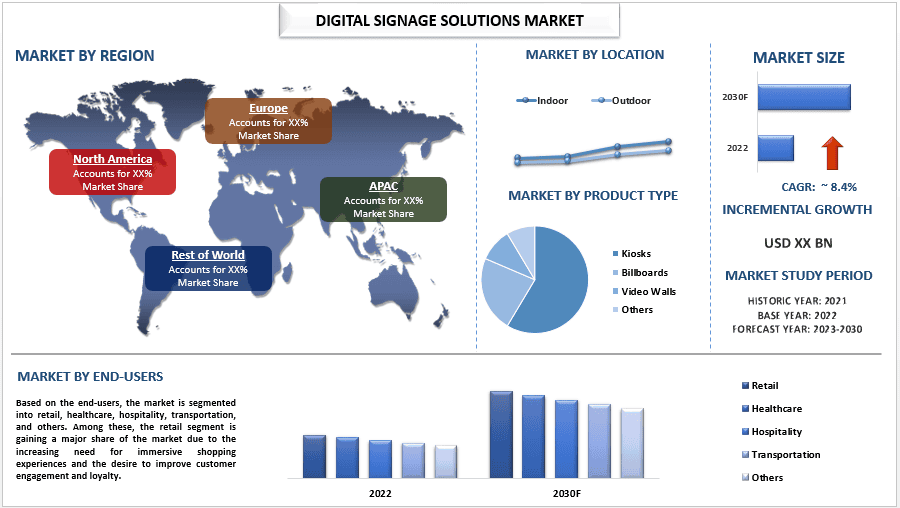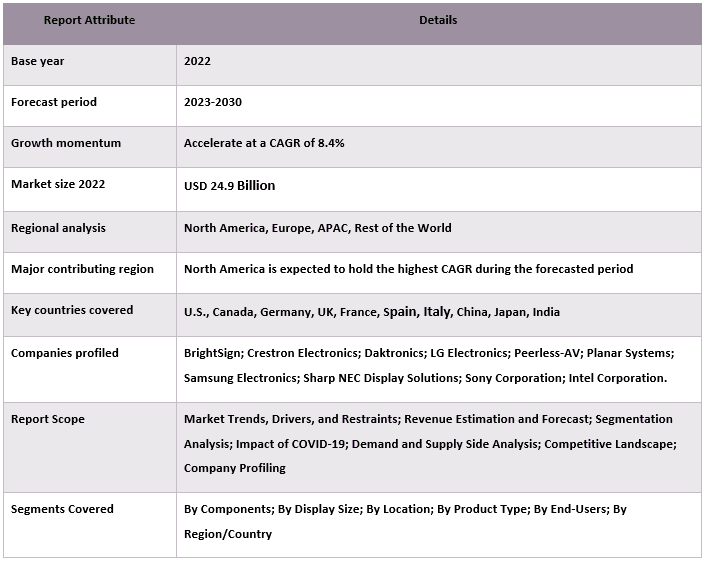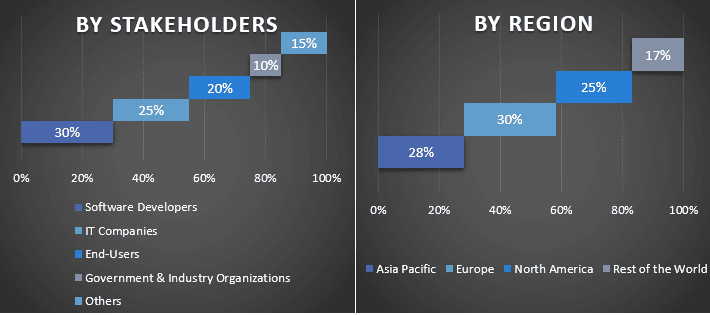- Home
- About Us
- Industry
- Services
- Reading
- Contact Us
Digital Signage Solutions Market: Current Analysis and Forecast (2023-2030)
Emphasis on Component (Hardware, Software, and Services); Display Size (Less Than 32 Inches, Between 32 And 52 Inches, and More Than 52 Inches); Location (Indoor, And Outdoor); Product Type (Kiosks, Billboards, Video Walls, and Others); End-Users (Retail, Healthcare, Hospitality, Transportation, and Others) and Region/Country.

The Digital Signage Solutions Market was valued at 24.9 billion in 2022 and is expected to grow at a steady rate of around 8.4% in the forecasted period (2023-2030) owing to the increasing focus on customer experience. Digital signage refers to the use of digital displays and technologies to communicate with audiences in public spaces such as retail stores, restaurants, and other venues. The digital signage solutions market includes hardware, software, and services that enable businesses to create, manage, and display content on these screens. Also, the growing demand of real-time communication and popularity of kiosks and virtual reality is driving the growth of the market. Furthermore, the Key players in the market, such as Samsung, LG, NEC, Sony, and Intel, play a significant role in driving market growth through their innovative products and services. For instance, in 2020 LG electronics launched “Digital Signage Solutions for Retail “.
Some of the major players operating in the market include BrightSign; Crestron Electronics; Daktronics; LG Electronics; Peerless-AV; Planar Systems; Samsung Electronics; Sharp NEC Display Solutions; Sony Corporation; Intel Corporation.
Insights Presented in the Report
“Among components, the hardware segment is currently holding a significant share of the market during forecast period.”
Based on the components, the market is segmented into hardware, software, and services. Among these, the hardware segment is currently holding a significant share of the market as physical components like displays, players, and others are in high demand because they help businesses display their messages and content clearly and effectively. One reason for the growth of the hardware segment is the increasing use of technology in retail and hospitality. For example, many stores and restaurants now use digital signs to show menus, prices, and promotions. These signs can be updated easily and quickly, which helps businesses keep their information current and relevant.
“Amongst display size, between 32 and 52 inches segment is currently leading during the forecast period.”
Based on the display size, the market is segmented less than 32 inches, between 32 and 52 inches, and more than 52 inches. Among these, the between 32 and 52 inches segment is currently leading the market. The reason for the growth of this segment is the increasing demand for interactive and engaging content. Displays between 32 and 52 inches offer a good balance between size and resolution, making them ideal for showing videos, images, and other multimedia content. This type of content is particularly effective at capturing the attention of customers and communicating information clearly.
“Amongst location, outdoor segment is currently leading during the forecast period.”
Based on the location, the market is bifurcated into indoor, and outdoor. Among these, the outdoor segment holds a considerable share of the market owing to the increasing demand for digital signage solutions in urban planning and public transportation. Additionally, advancements in technology have enabled the development of more durable and energy-efficient outdoor displays, further driving the growth of this segment. The outdoor segment is expected to continue its dominance in the coming years, driven by factors such as increased investment in smart cities and the need for real-time information dissemination.
“North America to hold a significant share in the market.”
The digital signage solutions market in North America is anticipated to hold the major share in the market as it is a growing industry, driven by increasing demand for digital advertising, need for real-time communication, and growing popularity of interactive kiosks & virtual reality experiences. This growth is fueled by the increasing adoption of digital signage solutions in various industries such as retail, hospitality, healthcare, education, and transportation in the region. Furthermore, the market is expected to continue growing in the coming years, driven by increasing demand for digital advertising, need for real-time communication, and growing popularity of interactive kiosks and virtual reality experiences.
Digital Signage Solutions Market Report Coverage

Reasons to buy this report:
- The study includes market sizing and forecasting analysis validated by authenticated key industry experts.
- The report presents a quick review of overall industry performance at one glance.
- The report covers an in-depth analysis of prominent industry peers with a primary focus on key business financials, product portfolio, expansion strategies, and recent developments.
- Detailed examination of drivers, restraints, key trends, and opportunities prevailing in the industry.
- The study comprehensively covers the market across different segments.
- Deep dive regional level analysis of the industry.
Customization Options:
The global Digital Signage Solutions Market can further be customized as per the requirement or any other market segment. Besides this, UMI understands that you may have your own business needs, hence feel free to contact us to get a report that completely suits your requirements.
Table of Content
Research Methodology for the Digital Signage Solutions Market Analysis
(2023-2030)
Analyzing the historical market, estimating the current market, and forecasting the future market of the global Digital Signage Solutions Market were the three major steps undertaken to create and analyze the adoption of Digital Signage Solutions Market in major regions globally. Exhaustive secondary research was conducted to collect the historical market numbers and estimate the current market size. Secondly, to validate these insights, numerous findings and assumptions were taken into consideration. Moreover, exhaustive primary interviews were also conducted, with industry experts across the value chain of the global Digital Signage Solutions Market. Post assumption and validation of market numbers through primary interviews, we employed a top-down/bottom-up approach to forecasting the complete market size. Thereafter, market breakdown and data triangulation methods were adopted to estimate and analyze the market size of segments and sub-segments of the industry pertains to. Detailed methodology is explained below:
Analysis of Historical Market Size
Step 1: In-Depth Study of Secondary Sources:
Detail secondary study was conducted to obtain the historical market size of the Digital Signage Solutions Market through company internal sources such as annual reports & financial statements, performance presentations, press releases, etc., and external sources including journals, news & articles, government publications, competitor publications, sector reports, third-party database, and other credible publications.
Step 2: Market Segmentation:
After obtaining the historical market size of the Digital Signage Solutions Market, we conducted a detailed secondary analysis to gather historical market insights and share for different segments & sub-segments for major regions. Major segments are included in the report as components, display size, location, product type, and end-users. Further country-level analyses were conducted to evaluate the overall adoption of testing models in that region.
Step 3: Factor Analysis:
After acquiring the historical market size of different segments and sub-segments, we conducted a detailed factor analysis to estimate the current market size of the Digital Signage Solutions Market. Further, we conducted factor analysis using dependent and independent variables such as various components, display size, location, product type, and end-users Digital Signage Solutions Market. A thorough analysis was conducted of demand and supply-side scenarios considering top partnerships, mergers and acquisitions, business expansion, and product launches in the Digital Signage Solutions Market sector across the globe.
Current Market Size Estimate & Forecast
Current Market Sizing: Based on actionable insights from the above 3 steps, we arrived at the current market size, key players in the global Digital Signage Solutions Market, and market shares of the segments. All the required percentage shares split, and market breakdowns were determined using the above-mentioned secondary approach and were verified through primary interviews.
Estimation & Forecasting: For market estimation and forecast, weights were assigned to different factors including drivers & trends, restraints, and opportunities available for the stakeholders. After analyzing these factors, relevant forecasting techniques i.e., the top-down/bottom-up approach were applied to arrive at the market forecast for 2030 for different segments and sub-segments across the major markets globally. The research methodology adopted to estimate the market size encompasses:
- The industry’s market size, in terms of revenue (USD) and the adoption rate of the Digital Signage Solutions Market across the major markets domestically
- All percentage shares, splits, and breakdowns of market segments and sub-segments
- Key players in the global Digital Signage Solutions Market in terms of products offered. Also, the growth strategies adopted by these players to compete in the fast-growing market.
Market Size and Share Validation
Primary Research: In-depth interviews were conducted with the Key Opinion Leaders (KOLs) including Top Level Executives (CXO/VPs, Sales Head, Marketing Head, Operational Head, Regional Head, Country Head, etc.) across major regions. Primary research findings were then summarized, and statistical analysis was performed to prove the stated hypothesis. Inputs from primary research were consolidated with secondary findings, hence turning information into actionable insights.
Split of Primary Participants in Different Regions

Market Engineering
The data triangulation technique was employed to complete the overall market estimation and to arrive at precise statistical numbers for each segment and sub-segment of the global Digital Signage Solutions Market. Data was split into several segments & sub-segments post studying various parameters and trends in the areas of components, display size, location, product type, and end-users in the global Digital Signage Solutions Market.
The main objective of the Global Digital Signage Solutions Market Study
The current & future market trends of the global Digital Signage Solutions Market were pinpointed in the study. Investors can gain strategic insights to base their discretion for investments on the qualitative and quantitative analysis performed in the study. Current and future market trends determined the overall attractiveness of the market at a regional level, providing a platform for the industrial participant to exploit the untapped market to benefit from a first-mover advantage. Other quantitative goals of the studies include:
- Analyze the current and forecast market size of the Digital Signage Solutions Market in terms of value (USD). Also, analyze the current and forecast market size of different segments and sub-segments.
- Segments in the study include areas of components, display size, location, product type, and end-users.
- Define and analysis of the regulatory framework for the Digital Signage Solutions Market industry.
- Analyze the value chain involved with the presence of various intermediaries, along with analyzing customer and competitor behaviors of the industry.
- Analyze the current and forecast market size of the Digital Signage Solutions Market for the major region.
- Major countries of regions studied in the report include Asia Pacific, Europe, North America, and the Rest of the World.
- Company profile of the Digital Signage Solutions Market and the growth strategies adopted by the market players to sustain in the fast-growing market.
- Deep dive regional level analysis of the industry
Frequently Asked Questions FAQs
Q1: What is the current market size and growth potential of the global Digital Signage Solutions Market?
Q2: What are the driving factors for the growth of the global Digital Signage Solutions Market?
Q3: Which segment has the largest share of the global Digital Signage Solutions Market by components?
Q4: Which region will dominate the global Digital Signage Solutions Market?
Q5: Who are the key players operating in the global Digital Signage Solutions Market?
Related Reports
Customers who bought this item also bought










